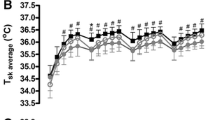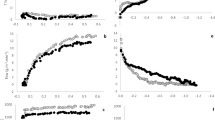Abstract
To examine thermoregulatory responses of prepubertal children to cold stress, 11 boys (aged 8 years) and 11 young men (aged 19–23 years), wearing only trunks, participated in this study. They sat in air at 28°C for 30 min (equilibrium period) and then in conditions where air temperature (T a) was decreased linearly from 28 to 15°C (at a constant rate of 0.22°C · min−1) for 60 min, at a fixed relative humidity of 65%. In the equilibrium period there was no significant difference between the groups for rectal temperature [T re, mean 37.30 (SEM 0.10) and mean 37.43 (SEM 0.14)°C in the boys and the men, respectively] or for the respective skin temperatures (except for the forehead), but metabolic heat production (\(\dot M\)) was significantly greater for the boys [mean 57.1 (SEM 1.2) and mean 52.0 (SEM 0.9)W. m−2,P <0.005]. With decliningT a, the skin temperatures decreased in both groups (P <0.001), but the decrease was significantly greater for the boys (P < 0.05), especially on the limbs as represented by the thigh and forearm. No significant correlations were observed between the limb skin temperatures compared to surface area-to-mass ratio or limb skinfold thicknesses in either group. The rate of increase in\(\dot M\) asT a decreased was significantly lower for the boys (P < 0.01) largely because of a higher\(\dot M\) before the cold exposure. Thus, the mean\(\dot M\) during the cold exposure did not differ between the groups [mean 63.6 (SEM 1.1) and mean 61.6 (SEM 1.1) W · m−2 in boys and men, respectively]. When theT a was lowered,T re in the boys started falling (P < 0.001), whereas theT re in the young men did not change for 60 min. TheT re during the 60-min exposure was significantly lower (P < 0.001) for the boys [mean 37.01 (SEM 0.13) and mean 37.48 (SEM 0.18)°C at the end of the exposure]. It was concluded that whenT a was lowered, the prepubertal boys appeared to vasoconstrict more in their limbs and to be somewhat more hypothermic, compared to the young men.
Similar content being viewed by others
References
Araki T, Toda Y, Matsushita K, Tsujino A (1979) Age differences in sweating during muscular exercise. J Physical Fitness Jpn 28:239–248
Araki T, Inoue Y, Umeno K (1980a) Effects of physical training on thermoregulatory responses to alternate stress of heat and cold. J Physical Fitness Jpn 29:75–81
Araki T, Tsujita J, Matsushita K, Hori S (1980b) Thermoregulatory responses of boys to heat and cold in relation to physical training. J Human Ergol 9:69–80
Bittel JHM, Nonotte-Varly C, Livecchi-Gonnot GH, Savourey GLMJ, Hanniquet AM (1988) Physical fitness and thermoregulatory reactions in a cold environment in men. J Appl Physiol 65:1984–1989
Budd GM, Brotherhood JR, Hendrie AL, Jeffery SE (1991) Effects of fitness, fatness, and age on men's responses to whole body cooling in air. J Appl Physiol 71:2387–2393
Buskirk ER, Thompson RH, Whedon GD (1963) Metabolic responses to cold air in men and women in relation to total body fat content. J Appl Physiol 18:603–612
Davies CTM (1981) Thermal responses to exercise in children. Ergonomics 24:55–61
Delamarche P, Bittel J, Lacour JR, Flandrois R (1990) Thermoregulation at rest and during exercise in prepubertal boys. Eur J Appl Physiol 60:436–440
Fujimoto S, Watanabe T (1969) Studies on the body surface area of Japanese. Acta Med Nagasaki 13:1–13
Inoue Y, Nakao M, Araki T, Murakami H (1991) Regional differences in the sweating responses of older and younger men. J Appl Physiol 71:2453–2459
Inoue Y, Nakao M, Araki T, Ueda H (1992) Thermoregulatory responses of young and older men to cold exposure. Eur J Appl Physiol 65:492–498
Inoue Y, Nakao M, Okudaira S; Ueda H, Araki T (1995a) Seasonal variation in sweating responses of older and younger men. Eur J Appl Physiol 70:6–12
Inoue Y, Nakao M, Ueda H, Araki T (1995b) Seasonal variation in physiological responses to mild cold air in young and older men. Int J Biometeorol 38:131–136
Shiraishi T, Araki T (1990) Comparative study on thermoregulation under heat exposure between children and adults:with special reference to sweating and skin temperature reactions (in Japanese). Jpn J School Health 32:134–143
Smolander J, Bar-Or O, Korhonen O, Ilmarinen J (1992) Thermoregulation during rest and exercise in the cold in pre- and early pubescent boys and in young men. J Appl Physiol 72:1589–1594
Wagner JA, Robinson S, Marino RP (1974) Age and temperature regulation of humans in neutral and cold environments. J Appl Physiol 37:562–565
Author information
Authors and Affiliations
Rights and permissions
About this article
Cite this article
Inoue, Y., Araki, T. & Tsujita, J. Thermoregulatory responses of prepubertal boys and young men in changing temperature linearly from 28 to 15°C. Europ. J. Appl. Physiol. 72, 204–208 (1996). https://doi.org/10.1007/BF00838639
Accepted:
Issue Date:
DOI: https://doi.org/10.1007/BF00838639




